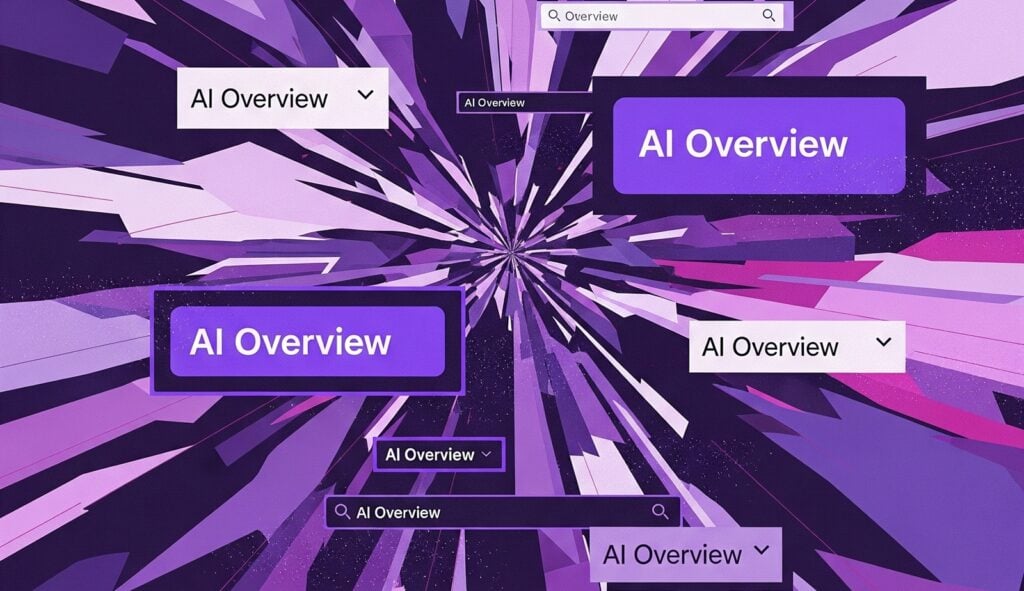Why isn’t Google AI Overview always at the top? (and What This Means for SEO)

The recent introduction of “AI Overview” in Google search results has sparked a wave of debate and, in some cases, fear within the SEO community. The truth is that for decades, Google has continued to reimagine and expand what Search can do, and new AI technologies are making search experiences more personalized and easier than ever.
Despite this, the concern is legitimate: if AI-generated answers satisfy a user’s query directly on the search results page, click-through rates (CTR) could plummet, harming website traffic. But what if the right question isn’t “will it kill my traffic,” but rather “why does it appear in lower positions (and not at the top)?” or “why doesn’t it appear for all queries?”
The answer to this question leads us to the core of Google’s ranking algorithm, a complex system that prioritizes a single objective: providing the most useful and reliable answer for the user. The position of each result—be it a website link, a Featured Snippet, or an AI Overview—is not random. It is the result of a detailed evaluation of various factors.
Let’s explore the main reasons behind this behavior.
1. Why does AI Overview appear in lower positions (and not at the top)?
When an AI Overview is displayed, but not at the top, the main reason is direct competition with results considered more authoritative or useful. Google is not simply replacing a link with an AI summary. It is evaluating which format and source offer the best experience for that specific query.
The Authority and Trustworthiness Factor (E-E-A-T)
Google has been investing heavily in refining its system to recognize the Experience, Expertise, Authoritativeness, and Trustworthiness of websites, a concept known as E-E-A-T. AI Overviews are built to display information that is supported by high-quality web results. When a user’s query demands concrete facts, the algorithm may prioritize sources that have already proven to be trusted leaders in their niche.
In the case of a search for “holidays,” websites like timeanddate.com specialize in this type of content and have a history of years of publications.

Going deeper, we’ve identified that Google first crawled these sites over 10 years ago.

Therefore, to be in those top positions, their publications are likely accurate, up-to-date, and highly engaging for users. For Google, the trust placed in these domains can outweigh the potential of an AI-generated summary, which, although factual, does not carry the same history of credibility.
One of the most effective strategies for demonstrating this authority is creating Topic Clusters, a methodology that deepens the coverage of relevant topics and builds a network of interconnected information, signaling your expertise on the subject to Google.
Response Relevance and Content Format
The usefulness of a result is measured not only by accuracy but also by its format. For many searches, a calendar, a detailed list, or an interactive interface on a website can be considered more useful and direct than a paragraph of AI-generated text.
Searches for specific formats: If the user is looking for a complete list of dates, such as “holidays in 2025,” a calendar or a well-organized list on a website can be considered the most useful answer. Google’s AI cannot deliver the same experience a user would have on the site.
Searches with mixed intent: In the case of a search for “harvard exam results,” the user’s primary intent is transactional: they want to know their score. However, Google does not have access to this personal information. Recognizing this limitation, the AI system understands that the next best thing to do is to answer a secondary, informational intent: how they can obtain that score. Therefore, it first displays the answer from a site with strong authority that can guide the user. Then, it tries to answer the user’s main questions with a Query Fan-Out, breaking down the query into “how to view the score,” “how the score can be used,” etc. The AI is smart enough to know that the best answer for the initial intent cannot be provided by it.

2. Why isn’t AI Overview displayed for certain queries?
In addition to competing for the top position, there are cases where the AI Overview is simply not displayed. The reason for this is intrinsically linked to the user’s search intent.
There are searches for which the user’s intent and the nature of the query itself make the display of an AI summary redundant, unnecessary, or even counterproductive. Google’s goal is to deliver the most useful information, and that is not always a text summary.
Searches for Specific Formats and Multimedia Experiences
For some queries, the system understands that the most useful and fastest answer is a link to a site that has already compiled the information in a complete and authoritative way, as an AI-generated summary would present incomplete or disorganized information.
The query “beaches in Portugal” is a perfect example. The user’s intent is visual and exploratory. They want to see photos, get options, and maybe even a map. Google understands that a text summary, no matter how hard it tries to list the beaches, does not satisfy this intent. The user needs a visual and exploratory experience, something that a travel site, with photo galleries and maps, can offer in a superior way.
Attempting to display a summary or apply a Query Fan-Out here, breaking it down into ‘beaches in the Algarve,’ ‘beaches in Lisbon,’ etc., would be less efficient than letting the user explore the visual options.

The AI Overview also remains absent from queries that require multimedia experiences, such as “how to sing in tune.” The system understands that a complete and useful answer for this query is only possible with a video that demonstrates vocal techniques and practical exercises. AI can decide to “prioritize visual information if the user’s question can benefit from an image or video.”
See? Not every ‘how-to’ or informational search generates an AI Overview. SERP analysis is fundamental to understanding user search intent and the content format that Google considers most useful for that type of query.
At this point, it’s important to explain the different formats for informational search intent, where the user wants to learn something.
- Simple informational intent: Ex: “What is the capital of Japan?” The user is looking for a fact. An AI Overview with a paragraph of text works perfectly.
- Complex informational intent: Ex: “How to sing in tune,” “how to barbecue,” “how to tie a tie.” The user wants to learn a process that requires practice and demonstration.
For complex informational intent, Google understands that text is not the best format for the answer. The SERP for “how to sing in tune” is dominated by YouTube videos and articles with video embeds, because the best way to learn to tune your voice is by watching and listening to an instructor.
Sensitive and Dangerous Topic Queries
Google prioritizes safety and reliability. Therefore, its systems are refined with the goal of “preventing AI Overviews from appearing for queries about highly sensitive, explicit, or dangerous topics.”
Transactional Searches
The AI Overview also remains absent from transactional searches, where purchase intent is implicit. When a user types “samsung phone,” they do not want a summary of technical specifications; they want to see products, prices, and where to buy.
The system understands that the best answer is a list of e-commerce sites. Similarly, in searches where the user intends to “take an action or complete a task on a website (for example, booking flights),” AI may “include hyperlinks in the response” instead of a summary.
Data Voids
The AI Overview was designed to display information supported by high-quality web results. However, for some searches (such as unusual or nonsensical queries), there may not be much high-quality information available on the web. In these situations, Google limits the display of the AI to prevent misleading, satirical, or useless content from being shown.
I recall that, when it was first launched, the AI Overview used to appear for more queries, but I believe the search engine is conducting tests to display AI strategically, and not as a rule for all searches.
This nuance shows the evolution of Google AI Overview and AI Mode. The algorithm is smart enough to discern where AI truly adds value to the search experience, and where the traditional search with “10 blue links” is still the best solution. Understanding its mechanisms, like the Muvera Algorithm, is fundamental to mastering the new era of SEO.
And most importantly: Google’s AI is focused on providing the most complete and useful answer for the initial intent of your query.
How can SEO adapt to this new landscape?
The AI Overview is still an evolving feature. What we see today may not be what we see six months from now, as Google is “continuously learning with each launch” and “committed to improving its processes when necessary.”
According to the document AI Overviews and AI Mode in Search, the company also plans to “transfer many of AI Mode’s features and capabilities to the main Search experience,” which reinforces the need for SEO professionals to be agile, constantly monitoring SERP changes for their clients’ most important terms. SERP analysis becomes a daily task, not just a one-off.
This reinforces the importance of an SEO strategy that goes beyond keywords. To compete in this dynamic landscape, professionals must focus on:
Building high-quality content: Create content that not only informs but also offers a better experience for the user. For professionals seeking efficiency, using a Content Briefing tool simplifies research and planning.
Optimizing for user Intent: To identify opportunities and improve your visibility in the AI Overview, the Google AI Mode Insights tool can be a great ally, helping you find the most relevant topics for your audience.
In conclusion, the position of the AI Overview in Google’s results is not a sign that AI has failed, but rather that the algorithm is working as it should: prioritizing utility, reliability, and user experience above all.
For us, professionals in the field, this scenario reinforces the need for a more strategic SEO that is centered on the real value we deliver to our audience.

